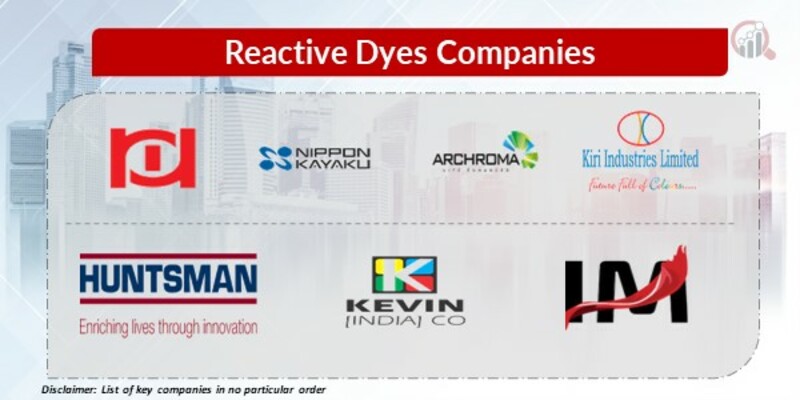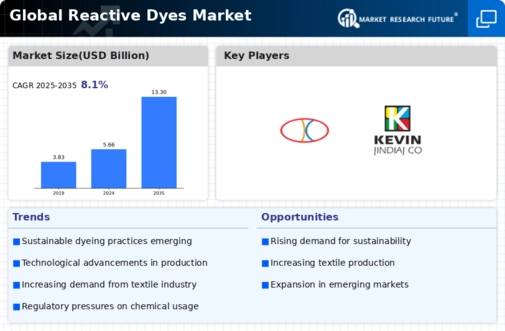Top Industry Leaders in the Reactive Dyes Market

Reactive Dyes Market
The vibrant world of textiles is awash with color, and the threads that hold this brilliance together are often dyed with reactive dyes. But beyond the aesthetic appeal lies a complex competitive landscape, where industry giants and niche players vie for market share. Let's delve into the intricate tapestry of the reactive dyes market, exploring its key strategies, drivers, news, and recent developments.
Strategies Stitching Success:
-
Innovation Threads: Players like Archroma and Huntsman Corporation are weaving in innovation with eco-friendly dyes, targeting sustainability-conscious consumers. Huntsman's launch of Avalan® reactive dyes promises improved wetfastness and reduced water consumption, while Archroma's EarthColors® range offers natural dyes for a green footprint. -
Market Diversification Weaves: Expanding beyond textiles, companies like Kiri Industries are diversifying into leather and paper dyeing, tapping into new revenue streams. This strategic weaving strengthens their market position and mitigates textile industry fluctuations. -
Acquisition Tapestry: Mergers and acquisitions are stitching together market dominance. In 2023, Zhejiang Runtu Co. acquired Zhejiang Jinguang Industrial, consolidating their hold on the Chinese reactive dyes market. Such moves create larger players with wider reach and production capacities. -
Pricing Plays: Strategic pricing remains a vital tool. Low-cost production in China and India allows companies like Jay Chemical Industries Limited and Colourtex to offer competitive prices, attracting price-sensitive buyers. However, established players like Sumitomo and Everlight Chemical counter with superior quality and technical expertise, commanding premium prices.
Factors Dyeing Market Share:
-
Textile Industry's Boom and Bust: The textile industry's growth, particularly in developing economies, fuels demand for reactive dyes. However, economic downturns and trade disruptions can unravel this growth, impacting market share. -
Environmental Regulations: Stringent environmental regulations are forcing a shift towards eco-friendly dyes. Companies with robust green dye portfolios gain an edge, while those lagging behind face market shrinkage. -
Technological Advancements: Innovations in dyeing technologies are reshaping the market. Cold brand reactive dyes, offering lower energy consumption and improved fabric quality, are gaining traction. Companies investing in R&D for such technologies gain a competitive edge. -
Regional Dynamics: The Asia Pacific region dominates the reactive dyes market, followed by Europe and North America. Emerging economies like India and Vietnam are witnessing rapid growth, while mature markets like Europe face challenges from stricter regulations and slower economic growth.
Key Companies in the Reactive Dyes market include
-
Huntsman International LLC,
-
Nippon Kayaku Co., Ltd.,
-
Sumika Chemtex Co., Ltd.,
-
Archroma, Colourtex,
-
Kiri Industries Ltd.,
-
IM Dye Chem,
-
Roop dyes and Intermediates,
-
Kevin India Co
Recent Developments Weaving the Future:
-
January 2024: Sumitomo announces a joint venture with a Korean company to develop high-performance reactive dyes for functional textiles used in sportswear and outdoor gear. -
March 2024: The Indian government announces plans to invest in research and development of sustainable dyeing technologies, potentially creating new opportunities for innovative players. -
April 2024: A group of leading textile manufacturers forms a consortium to develop a blockchain-based platform for tracking the use of dyes throughout the supply chain, promoting transparency and sustainability.










